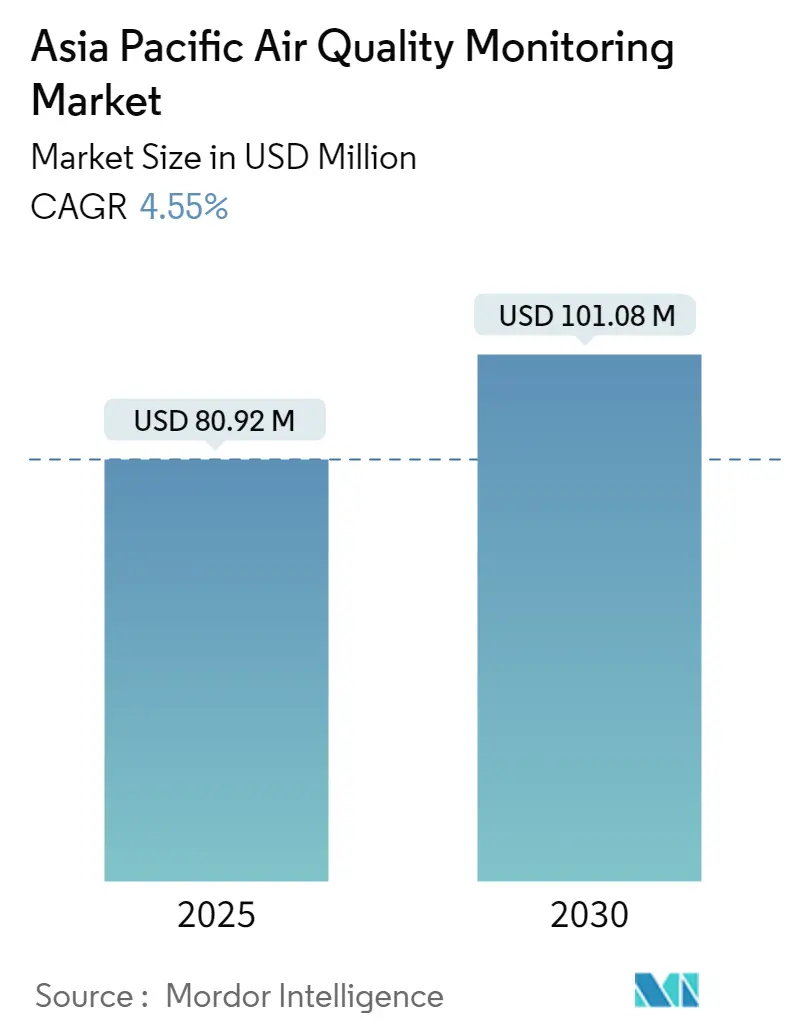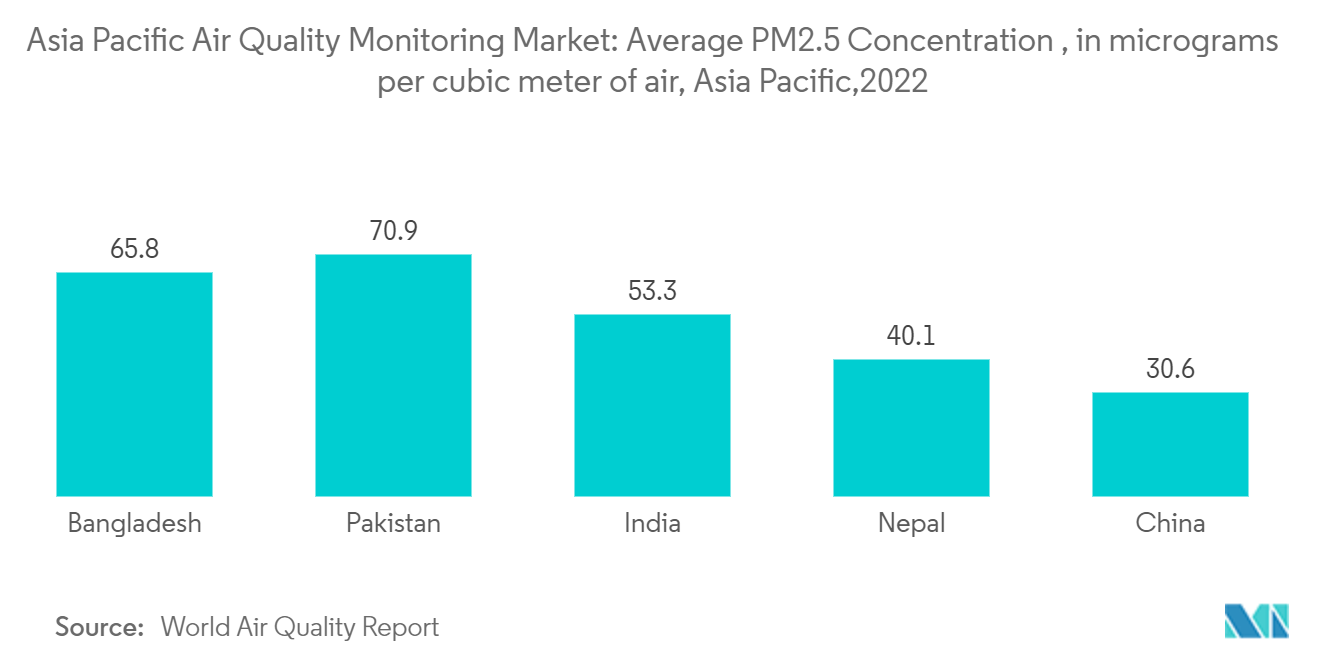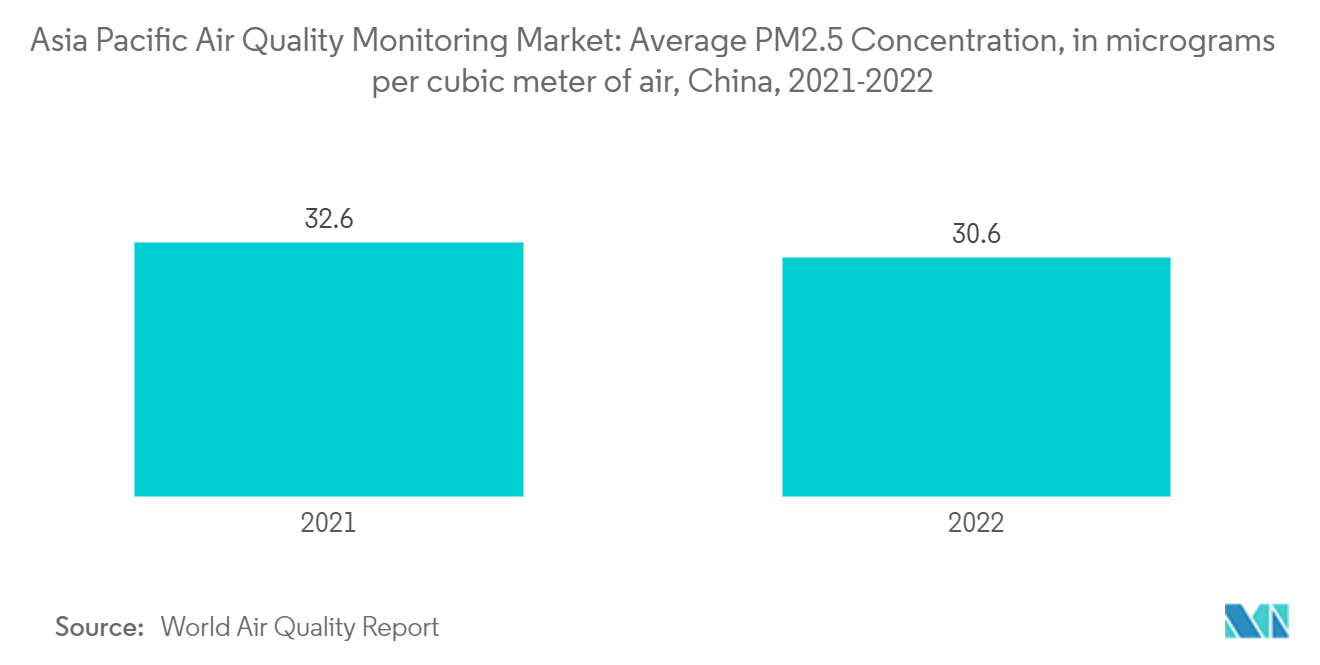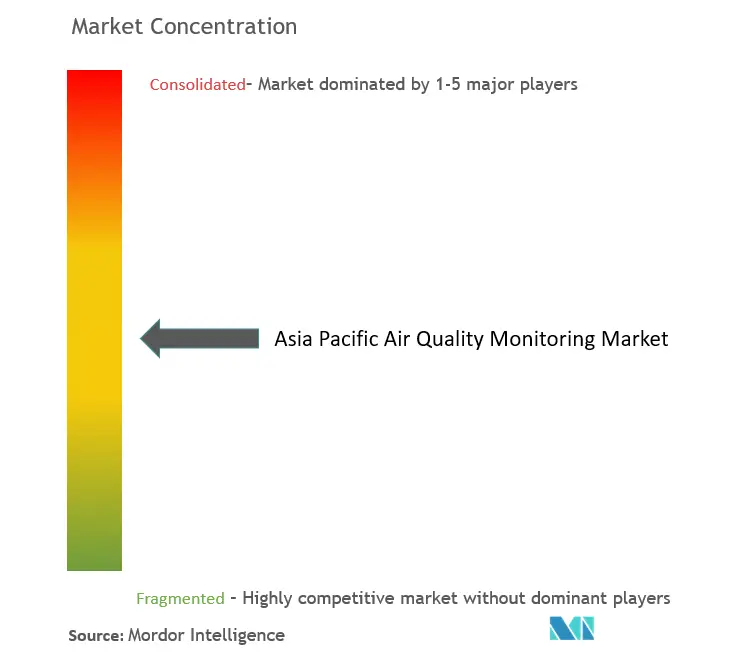
Asia Pacific Air Quality Monitoring Market Analysis
The Asia Pacific Air Quality Monitoring Market size is estimated at USD 80.92 million in 2025, and is expected to reach USD 101.08 million by 2030, at a CAGR of 4.55% during the forecast period (2025-2030).
- Over the medium term, increasing awareness and favorable government policies and non-government initiatives for curbing air pollution are expected to drive the market's growth.
- On the other hand, the high costs of air quality monitoring systems are expected to hamper the growth of the Asia Pacific air quality monitoring market during the forecast period. \
- Nevertheless, increasing technological advancements in air quality monitoring systems will likely create lucrative growth opportunities for the Asia Pacific air quality monitoring market in the forecast period.
Asia Pacific Air Quality Monitoring Market Trends
Outdoor Segment to Witness Significant Growth
- The outdoor air quality monitoring systems measure the concentration levels of pollutants, suspended particles, humidity, and temperature in outside air, i.e., in open spaces. They detect the levels of pollutants like CO2, O3, NO2, SO2, formaldehyde (HCHO), total volatile organic compounds (TVOC), etc.
- Pakistan had an average PM2.5 concentration of 70.9 micrograms per cubic meter of air (µg/m3) in 2022, making it one of the most polluted country in the world. This was almost 18 µg/m3 more than the average PM2.5 concentrations in India.
- Air quality monitoring systems are majorly deployed by the respective governments in cities and public spaces of a particular state or country. These devices are weather-resistant and must meet certain environmental tests and simulations to be confided by some building certifications.
- The outdoor monitors are further segmented into portable outdoor monitors, fixed outdoor monitors, dust and particulate monitors, and AQM stations. Portable outdoor monitors are the most widely deployed globally due to their operational advantage and easy deployment.
- With the increasing urbanization and more people moving to urban areas, the air pollution levels in urban areas have increased. It is estimated that by 2050, 2.5 billion more people will live in urban areas. The high population density and diverse pollution sources like industrial facilities, municipal waste generation, and transport congestion lead to an urge for better air quality monitoring and addressal systems.
- In April 2022, Oizom stated that the company installed 129 air quality monitors across nine smart cities in India. The Government launched the 100 Smart Cities program in 2015, for which Oizom has pioneered in providing robust, accurate, and compact solutions for air quality monitoring. Oizom initiated its installation in Kakinada Smart City in 2017 and eventually expanded to eight other cities over five years, such as Varanasi, Gandhinagar, Surat, Itanagar, Davangere, Imphal, and Agra.
- Therefore, owing to such developments are expected to give a thrust to the outdoor monitor segment of the market during the forecast period.

China to Dominate the Market
- According to the World Air Quality Report 2021, among the top 10 most polluted countries in the world, five were from the Asia-Pacific region. Among the top 20 polluted countries, eight were from the region.
- As of 2022, China stands at 25th position with an average of 30.6 µg/m³ PM2.5 concentration weighted by population according to the World Air Quality Report. According to the world air quality report, in 2022, the 18 most polluted regional cities in East Asia were from China. Over a million people are estimated to die annually from air pollution in China. However, currently, the country is fighting back with innovative solutions.
- China has a long history of using air quality monitoring systems; the country started monitoring air quality in a few cities in the 1970s and set up an initial national monitoring system in the 1980s. In 2000, the daily Air Pollution Index (API) based on NO2, PM10, and SO2 monitoring data was introduced in the country to assess air quality in 42 cities.
- In recent years, the Government of China has significantly improved air quality monitor coverage. The number of federal air monitoring stations across China increased from 661 to 1,800 between 2012 and 2020. This is in addition to thousands of air monitoring stations being managed and funded by the local governments.
- In recent years, air quality monitoring has drawn attention due to the extensive concerns regarding air pollution in China. China's air quality monitoring industry has grown faster than expected in recent years.
- However, this technology has been concentrated mainly in urban where it is most required. As public interest and regulatory bodies focus on improving air quality, the Chinese air quality monitoring market is expected to have a positive outlook during the forecast period.

Asia Pacific Air Quality Monitoring Industry Overview
The Asia Pacific air quality monitoring market is semi-consolidated in nature. Some of the major players in the market (in no particular order) include Siemens AG, Thermo Fisher Scientific Inc., 3M Co., Honeywell International Inc., and Teledyne Technologies Inc., among others.
In February 2022, Honeywell launched its Indoor Air Quality (IAQ) monitor, which forewarns building owners and operators of potential issues to proactively enhance indoor air quality, thereby potentially reducing the risk of transmitting airborne contaminants. A Make in India product, the compact, touchscreen-enabled device measures key IAQ parameters, including relative humidity, temperature, and indoor air pollutants. It provides an IAQ index based on the readings.
Asia Pacific Air Quality Monitoring Market Leaders
-
Siemens AG
-
Thermo Fisher Scientific Inc.
-
3M Co.
-
Honeywell International Inc.
-
Teledyne Technologies Inc.
- *Disclaimer: Major Players sorted in no particular order
Asia Pacific Air Quality Monitoring Market News
- Januaru 2023: The government of India launched the Technology for Air Quality Monitoring System (AI-AQMS v1.0) developed under MeitY-supported projects. The Centre for Development of Advanced Computing (C-DAC), Kolkata, in partnership with TeXMIN, ISM, Dhanbad under the ‘National program on Electronics and ICT applications in Agriculture and Environment (AgriEnIcs)’ has developed an outdoor air quality monitoring station to monitor environmental pollutants which includes parameters like PM 1.0, PM 2.5, PM 10.0, SO2, NO2, CO, O2, ambient temperature, relative humidity etc., for continuous air quality analysis of the environment.
- September 2022: The Asian Development Bank (ADB) launched the Asia Clean Blue Skies Program (ACBSP) to scale up ADB's investments in improving air quality in Asia and the Pacific. ADB launched the ACBSP at the Fourth Asia Pacific Clean Air Partnership joint forum in Seoul, Korea. The program supports the development and strengthening of policies and plans for ADB's developing member countries (DMCs) so that investments are stimulated in air quality projects, such as greenhouse gas reductions in energy, agriculture, transportation, industrial development, and urban development.
Asia Pacific Air Quality Monitoring Industry Segmentation
An air quality monitoring system is a sensor-based instrument that detects and monitors the levels of pollutants, such as sulfur dioxide, nitrous oxide, particulate matter, carbon monoxide, and volatile organic compounds, in indoor and outdoor environments.
The Asia Pacific air quality monitoring market is segmented by product type, sampling method, pollutant type, end user, and geography. By product type, the market is segmented into indoor monitors and outdoor monitors. By sampling method, the market is segmented into continuous, manual, and intermittent. By pollutant type, the market is segmented into chemical pollutants, physical pollutants, and biological pollutants. By end user, the market is segmented into residential and commercial, power generation, petrochemicals, and other end users. The report also covers the market size and forecasts for the Asia Pacific air quality monitoring market across major countries in the region. For each segment, the market sizing and forecasts have been done based on revenue (USD).
| Product Type | Indoor Monitor |
| Outdoor Monitor | |
| Sampling Method | Continuous |
| Manual | |
| Intermittent | |
| Pollutant Type | Chemical Pollutants |
| Physical Pollutants | |
| Biological Pollutants | |
| End User | Residential and Commercial |
| Power Generation | |
| Petrochemicals | |
| Other End Users | |
| Geography | China |
| India | |
| Japan | |
| Singapore | |
| Rest of Asia-Pacific |
Asia Pacific Air Quality Monitoring Market Research Faqs
How big is the Asia Pacific Air Quality Monitoring Market?
The Asia Pacific Air Quality Monitoring Market size is expected to reach USD 80.92 million in 2025 and grow at a CAGR of 4.55% to reach USD 101.08 million by 2030.
What is the current Asia Pacific Air Quality Monitoring Market size?
In 2025, the Asia Pacific Air Quality Monitoring Market size is expected to reach USD 80.92 million.
Who are the key players in Asia Pacific Air Quality Monitoring Market?
Siemens AG, Thermo Fisher Scientific Inc., 3M Co., Honeywell International Inc. and Teledyne Technologies Inc. are the major companies operating in the Asia Pacific Air Quality Monitoring Market.
What years does this Asia Pacific Air Quality Monitoring Market cover, and what was the market size in 2024?
In 2024, the Asia Pacific Air Quality Monitoring Market size was estimated at USD 77.24 million. The report covers the Asia Pacific Air Quality Monitoring Market historical market size for years: 2020, 2021, 2022, 2023 and 2024. The report also forecasts the Asia Pacific Air Quality Monitoring Market size for years: 2025, 2026, 2027, 2028, 2029 and 2030.
Our Best Selling Reports
Asia Pacific Air Quality Monitoring Industry Report
Statistics for the 2025 Asia Pacific Air Quality Monitoring market share, size and revenue growth rate, created by Mordor Intelligence™ Industry Reports. Asia Pacific Air Quality Monitoring analysis includes a market forecast outlook for 2025 to 2030 and historical overview. Get a sample of this industry analysis as a free report PDF download.




